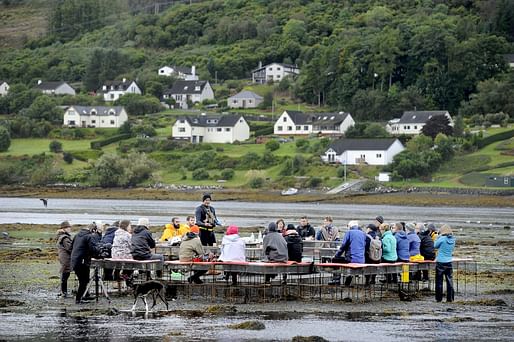

Alon Schwabe and Daniel Fernández Pascual of the London-based studio Cooking Sections explore food systems through architecture, ecology, visual arts, and geopolitics.
Featured in the second issue of Archinect's print publication Ed Issue 2, The Architecture of Disaster, the duo discussed their project CLIMAVORE: On Tidal Zones. Using a lightweight installation to explore the changing nature of Loch Portree's waters in Scotland, the pair explains their goals to adapt to changing ecosystems through food and architecture. A project that is both a "performance project and a form of responsive eating—a model Schwabe and Fernández have developed as a possible method for adaptation to the precarious conditions of climate change."
Recently, Schwabe and Pascual debuted their latest project, Salmon: A Red Herring, at the Tate Britain. Part of the museum's Art Now series showcasing emerging talent, the exhibition was an extension of their latest book Salmon: A Red Herring, published by isolarii (2020). The duo explains the investigation "explores the deceptive reality of salmon as a color and as a fish." Conducted as a performative installation, they add "the project is centered around the collaboration with Tate to remove farmed salmon off ts menus across all four Tate sites and introduce a CLIMAVORE dish instead."
Below is a description of the project and its goals taken from the Cooking Sections site.
Salmon is usually thought of as pink. The colour is even called ‘salmon pink’. However, farmed salmon today would be grey. To make them the expected colour, synthetic pigments are added to their feed. Salmon are farmed in open nets, whose runoff has a severe impact on wild salmon populations, as well as on the seabed of the west coast of Scotland at large. Salmon is the colour of a wild fish which is neither wild, nor fish, nor even salmon. The changing colours of species around the planet are warning signs of an environmental crisis. Many of these alterations result from humans and animals ingesting and absorbing synthetic substances. Changes in flesh, scales, feathers, skin, leaves or wings give us clues to environmental and metabolic transformations around us and inside us. Continuing our work on the Isle of Skye, Salmon: A Red Herring questions what colours we expect in our ‘natural’ environment. It asks us to examine how our perception of colour is changing as much as we are changing the planet.
The exhibition was on display until February 28, 2021, yet with the Tate Britian's closure due to Covid-19 health and safety regulations, it plans on re-opening sometime this May. The exhibition will be extended for a few additional months for public viewing. Dates are yet to be confirmed. To catch up with the duo, a recent conversation with Andrew Dickson from The Guardian shared Schwabe and Pascual are busy preparing for the upcoming project with London's Serpentine Gallery slated to launch this Spring.
Daniel Fernandez Pascual was the 2020 Wheelwright Prize Winner. Read Archinect's exclusive interview with Pascual here.
No Comments
Block this user
Are you sure you want to block this user and hide all related comments throughout the site?
Archinect
This is your first comment on Archinect. Your comment will be visible once approved.